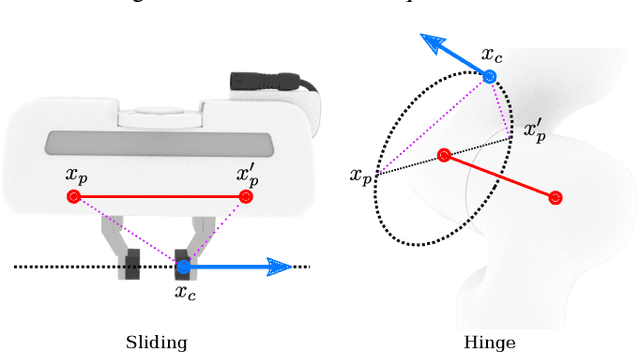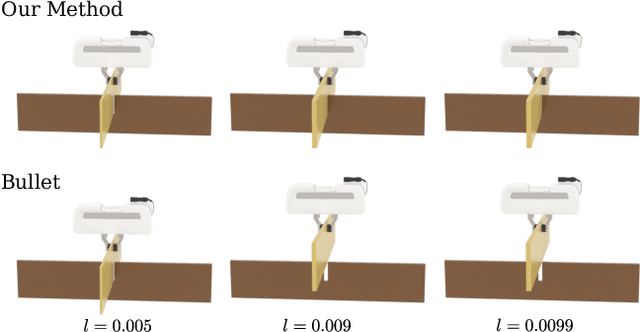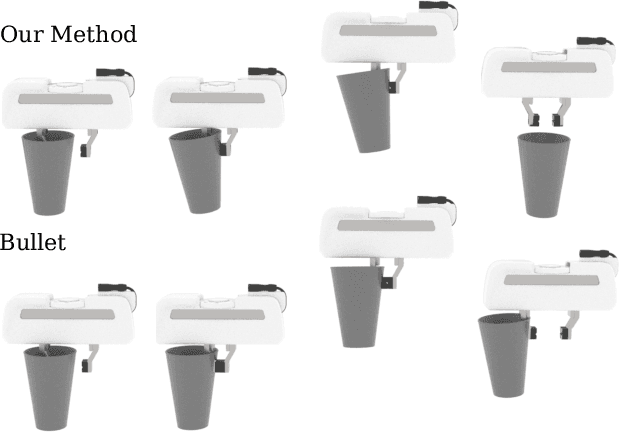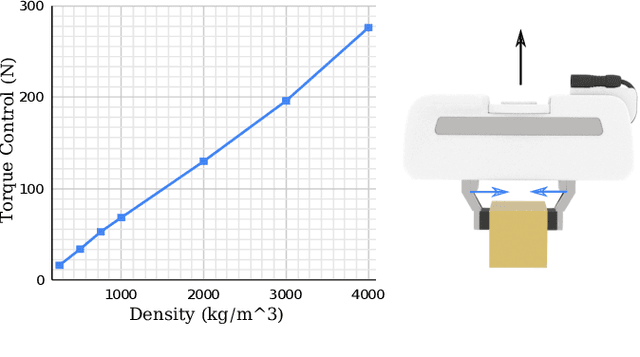Yunuo Chen
GRIP: A General Robotic Incremental Potential Contact Simulation Dataset for Unified Deformable-Rigid Coupled Grasping
Mar 06, 2025Abstract:Grasping is fundamental to robotic manipulation, and recent advances in large-scale grasping datasets have provided essential training data and evaluation benchmarks, accelerating the development of learning-based methods for robust object grasping. However, most existing datasets exclude deformable bodies due to the lack of scalable, robust simulation pipelines, limiting the development of generalizable models for compliant grippers and soft manipulands. To address these challenges, we present GRIP, a General Robotic Incremental Potential contact simulation dataset for universal grasping. GRIP leverages an optimized Incremental Potential Contact (IPC)-based simulator for multi-environment data generation, achieving up to 48x speedup while ensuring efficient, intersection- and inversion-free simulations for compliant grippers and deformable objects. Our fully automated pipeline generates and evaluates diverse grasp interactions across 1,200 objects and 100,000 grasp poses, incorporating both soft and rigid grippers. The GRIP dataset enables applications such as neural grasp generation and stress field prediction.
Large Language Model for Lossless Image Compression with Visual Prompts
Feb 22, 2025



Abstract:Recent advancements in deep learning have driven significant progress in lossless image compression. With the emergence of Large Language Models (LLMs), preliminary attempts have been made to leverage the extensive prior knowledge embedded in these pretrained models to enhance lossless image compression, particularly by improving the entropy model. However, a significant challenge remains in bridging the gap between the textual prior knowledge within LLMs and lossless image compression. To tackle this challenge and unlock the potential of LLMs, this paper introduces a novel paradigm for lossless image compression that incorporates LLMs with visual prompts. Specifically, we first generate a lossy reconstruction of the input image as visual prompts, from which we extract features to serve as visual embeddings for the LLM. The residual between the original image and the lossy reconstruction is then fed into the LLM along with these visual embeddings, enabling the LLM to function as an entropy model to predict the probability distribution of the residual. Extensive experiments on multiple benchmark datasets demonstrate our method achieves state-of-the-art compression performance, surpassing both traditional and learning-based lossless image codecs. Furthermore, our approach can be easily extended to images from other domains, such as medical and screen content images, achieving impressive performance. These results highlight the potential of LLMs for lossless image compression and may inspire further research in related directions.
Dress-1-to-3: Single Image to Simulation-Ready 3D Outfit with Diffusion Prior and Differentiable Physics
Feb 05, 2025



Abstract:Recent advances in large models have significantly advanced image-to-3D reconstruction. However, the generated models are often fused into a single piece, limiting their applicability in downstream tasks. This paper focuses on 3D garment generation, a key area for applications like virtual try-on with dynamic garment animations, which require garments to be separable and simulation-ready. We introduce Dress-1-to-3, a novel pipeline that reconstructs physics-plausible, simulation-ready separated garments with sewing patterns and humans from an in-the-wild image. Starting with the image, our approach combines a pre-trained image-to-sewing pattern generation model for creating coarse sewing patterns with a pre-trained multi-view diffusion model to produce multi-view images. The sewing pattern is further refined using a differentiable garment simulator based on the generated multi-view images. Versatile experiments demonstrate that our optimization approach substantially enhances the geometric alignment of the reconstructed 3D garments and humans with the input image. Furthermore, by integrating a texture generation module and a human motion generation module, we produce customized physics-plausible and realistic dynamic garment demonstrations. Project page: https://dress-1-to-3.github.io/
Towards Physical Understanding in Video Generation: A 3D Point Regularization Approach
Feb 05, 2025Abstract:We present a novel video generation framework that integrates 3-dimensional geometry and dynamic awareness. To achieve this, we augment 2D videos with 3D point trajectories and align them in pixel space. The resulting 3D-aware video dataset, PointVid, is then used to fine-tune a latent diffusion model, enabling it to track 2D objects with 3D Cartesian coordinates. Building on this, we regularize the shape and motion of objects in the video to eliminate undesired artifacts, \eg, nonphysical deformation. Consequently, we enhance the quality of generated RGB videos and alleviate common issues like object morphing, which are prevalent in current video models due to a lack of shape awareness. With our 3D augmentation and regularization, our model is capable of handling contact-rich scenarios such as task-oriented videos. These videos involve complex interactions of solids, where 3D information is essential for perceiving deformation and contact. Furthermore, our model improves the overall quality of video generation by promoting the 3D consistency of moving objects and reducing abrupt changes in shape and motion.
S4D: Streaming 4D Real-World Reconstruction with Gaussians and 3D Control Points
Aug 23, 2024Abstract:Recently, the dynamic scene reconstruction using Gaussians has garnered increased interest. Mainstream approaches typically employ a global deformation field to warp a 3D scene in the canonical space. However, the inherently low-frequency nature of implicit neural fields often leads to ineffective representations of complex motions. Moreover, their structural rigidity can hinder adaptation to scenes with varying resolutions and durations. To overcome these challenges, we introduce a novel approach utilizing discrete 3D control points. This method models local rays physically and establishes a motion-decoupling coordinate system, which effectively merges traditional graphics with learnable pipelines for a robust and efficient local 6-degrees-of-freedom (6-DoF) motion representation. Additionally, we have developed a generalized framework that incorporates our control points with Gaussians. Starting from an initial 3D reconstruction, our workflow decomposes the streaming 4D real-world reconstruction into four independent submodules: 3D segmentation, 3D control points generation, object-wise motion manipulation, and residual compensation. Our experiments demonstrate that this method outperforms existing state-of-the-art 4D Gaussian Splatting techniques on both the Neu3DV and CMU-Panoptic datasets. Our approach also significantly accelerates training, with the optimization of our 3D control points achievable within just 2 seconds per frame on a single NVIDIA 4070 GPU.
Atlas3D: Physically Constrained Self-Supporting Text-to-3D for Simulation and Fabrication
May 28, 2024



Abstract:Existing diffusion-based text-to-3D generation methods primarily focus on producing visually realistic shapes and appearances, often neglecting the physical constraints necessary for downstream tasks. Generated models frequently fail to maintain balance when placed in physics-based simulations or 3D printed. This balance is crucial for satisfying user design intentions in interactive gaming, embodied AI, and robotics, where stable models are needed for reliable interaction. Additionally, stable models ensure that 3D-printed objects, such as figurines for home decoration, can stand on their own without requiring additional supports. To fill this gap, we introduce Atlas3D, an automatic and easy-to-implement method that enhances existing Score Distillation Sampling (SDS)-based text-to-3D tools. Atlas3D ensures the generation of self-supporting 3D models that adhere to physical laws of stability under gravity, contact, and friction. Our approach combines a novel differentiable simulation-based loss function with physically inspired regularization, serving as either a refinement or a post-processing module for existing frameworks. We verify Atlas3D's efficacy through extensive generation tasks and validate the resulting 3D models in both simulated and real-world environments.
Bayesian Neural Networks Tend to Ignore Complex and Sensitive Concepts
Feb 25, 2023



Abstract:In this paper, we focus on mean-field variational Bayesian Neural Networks (BNNs) and explore the representation capacity of such BNNs by investigating which types of concepts are less likely to be encoded by the BNN. It has been observed and studied that a relatively small set of interactive concepts usually emerge in the knowledge representation of a sufficiently-trained neural network, and such concepts can faithfully explain the network output. Based on this, our study proves that compared to standard deep neural networks (DNNs), it is less likely for BNNs to encode complex concepts. Experiments verify our theoretical proofs. Note that the tendency to encode less complex concepts does not necessarily imply weak representation power, considering that complex concepts exhibit low generalization power and high adversarial vulnerability.
Midas: A Multi-Joint Robotics Simulator with Intersection-Free Frictional Contact
Sep 30, 2022



Abstract:We introduce Midas, a robotics simulation framework based on the Incremental Potential Contact (IPC) model. Our simulator guarantees intersection-free, stable, and accurate resolution of frictional contact. We demonstrate the efficacy of our framework with experimental validations on high-precision tasks and through comparisons with Bullet physics. A reinforcement learning pipeline using Midas is also developed and tested to perform intersection-free peg-in-hole tasks.
 Add to Chrome
Add to Chrome Add to Firefox
Add to Firefox Add to Edge
Add to Edge